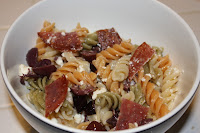
Artichokes (and how to eat them)
Servings: 2 (only 2-3 fit in a pot!)
Time: 45-55 minutes (5 minutes prep)
2 medium to large fresh artichokes
2 cloves of garlic
1 tablespoon olive oil
lemon juice
butter (melted)
Fill a large, 4-5 quart pot with water. Add no more than a tablespoon of olive oil. Peel the garlic, slice into a few, large pieces and add to the pot as well. Bring water to boil. Using a large knife, cut about an inch off of the top of the artichoke. The idea is to rid the 'leaves' of many of their thorny tops. Some people like to get the tops of any missed leaves with a pair of kitchen scissors. Cut off the stem, leaving an inch or less at the base. Once the water boils, carefully drop in the artichokes. Reduce the heat to medium or even medium low, keeping the water at a gentle, rolling boil. I usually cover the artichokes while they cook, although some people leave the lid off to decrease the bitterness of the artichokes. The artichokes will pretty much be fine on their own while they cook for about 45 minutes to an hour, depending on the size of the artichoke (larger ones take longer). I do like to roll the artichokes around in the water with a fork, occasionally. When done, the leaves should be able to be easily separated from the base.
To make the dipping sauce, combine 2 tablespoons of melted butter with about a table spoon of lemon juice. Add more lemon juice to taste. The sauce should be on the tart side, as it pairs really well with the slightly bitter artichoke.

How to Eat Artichokes
1. Peel off each of the primary 'scales' - the leaf looking things - and draw the base of the scale through your teeth, scraping off the delicious, tender meat.

2. As you get closer to the center the 'scales' will become much smaller and translucent. Some may be purple. You can carefully bite off the base, but stay away from the small spine at the tip!

3. When you get to the 'choke' (really the unopened flower), which looks stringy in the photo below, you'll need to scrape off all the chokey bits (Don't eat), leaving the 'heart'(base) intact.



4. Cut up the tender heart and stem and dip in the butter. Definitely the best part of the artichoke!





